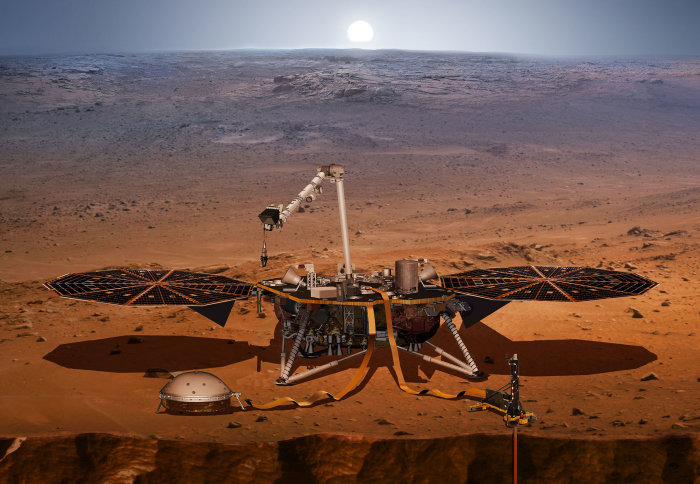Marsquake sensor lands safely on Red Planet

A Marsquake detector designed in part by Imperial engineers is set to help reveal Mars’ inner structure.
Mars InSight, the NASA probe which contains the detector, was launched on 5 May 2018 from the Vandenberg Air Force Base in California, and touched down on the Red Planet at 19:53 GMT on 26 November.
The first mission to study the deep interior of Mars will generate unprecedented data about its inner structure. Evidence of a liquid core could hint at the likelihood of previous life on the Red Planet billions of years ago.
Mission to Mars! – Imperial's role
Professor Tom Pike, from Imperial’s Department of Electrical and Electronic Engineering, is part of the Mars Insight team. The Imperial team designed and fabricated silicon sensors as part of the Seismic Experiment for Interior Structure (SEIS), which will detect tremors below the Martian surface.
Studying Mars lets us travel to the solar system’s ancient past. Professor Tom Pike Department of Electrical and Electronic Engineering
From the tremors, the mission will build a picture of Mars’ interior and help researchers detect a solid or liquid core. The remains of a liquid core could suggest that Mars once had a magnetic field. Like on Earth, the field would have protected it from harmful solar winds billions of years ago. Back then, Mars then was much warmer and wetter, and might have been capable of harbouring early life.
Professor Pike said: “Studying Mars lets us travel to the solar system’s ancient past. While Earth and Venus' tectonic systems have destroyed most of the evidence of their early history, much of the Red Planet has remained static for more than three billion years.”
For more on Imperial's role in the Mars Insight mission, read Caroline Brogan's report from Insight's launch in May this year and read Prof Pike's latest 'InSight Diary' on BBC Online.
On the night
The Imperial community watched with bated breath as InSight made its seven-minute descent on to the surface of Mars.
–
All images are credited to NASA/JPL-Caltech/MSSS
Article supporters
Article text (excluding photos or graphics) © Imperial College London.
Photos and graphics subject to third party copyright used with permission or © Imperial College London.
Reporter
Caroline Brogan
Communications Division
Andrew Youngson
Communications Division